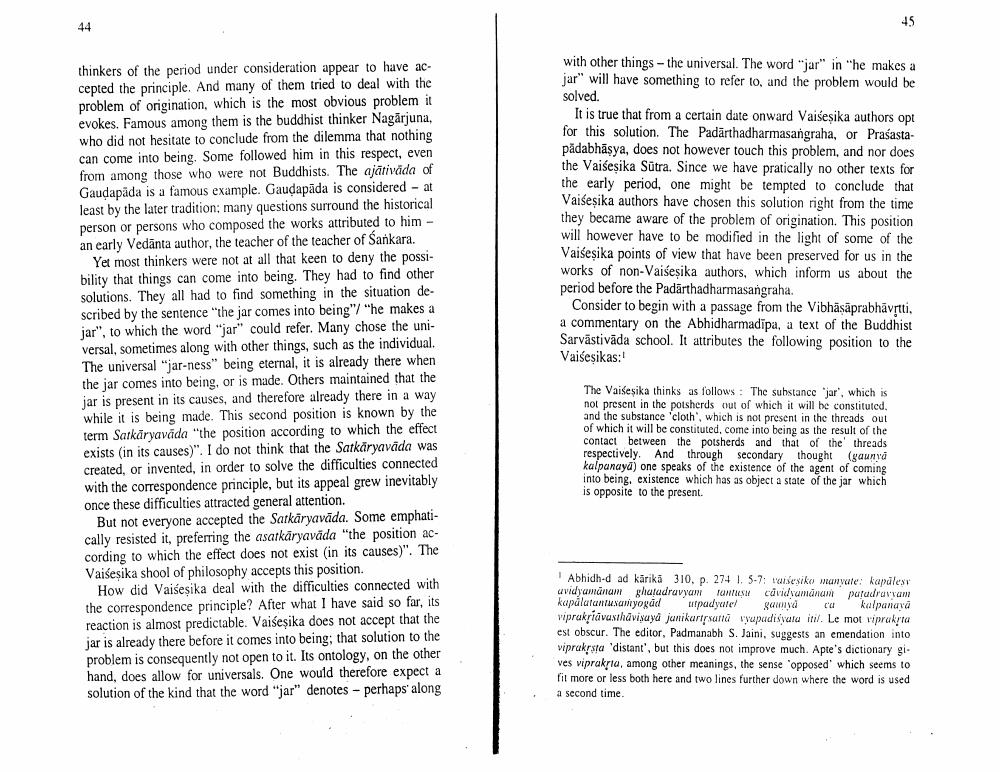Book Title: Satkaryavada And Asatkaryavada Author(s): Johannes Bronkhorst Publisher: Johannes Bronkhorst View full book textPage 2
________________ with other things - the universal. The word "jar" in "he makes a jar" will have something to refer to, and the problem would be solved. It is true that from a certain date onward Vaiseșika authors opt for this solution. The Padārthadharmasangraha, or Prasastapädabhāşya, does not however touch this problem, and nor does the Vaišesika Sütra. Since we have pratically no other texts for the early period, one might be tempted to conclude that Vaišeșika authors have chosen this solution right from the time they became aware of the problem of origination. This position will however have to be modified in the light of some of the Vaiseșika points of view that have been preserved for us in the works of non-Vaiseșika authors, which inform us about the period before the Padārthadharmasangraha Consider to begin with a passage from the Vibhäsāprabhavrtti, a commentary on the Abhidharmadipa, a text of the Buddhist Sarvästivāda school. It attributes the following position to the Vaišesikas: thinkers of the period under consideration appear to have accepted the principle. And many of them tried to deal with the problem of origination, which is the most obvious problem it evokes. Famous among them is the buddhist thinker Nagarjuna, who did not hesitate to conclude from the dilemma that nothing can come into being. Some followed him in this respect, even from among those who were not Buddhists. The ajativada of Gaudapäda is a famous example. Gaudapāda is considered - at least by the later tradition; many questions surround the historical person or persons who composed the works attributed to him - an early Vedānta author, the teacher of the teacher of Sankara. Yet most thinkers were not at all that keen to deny the possibility that things can come into being. They had to find other solutions. They all had to find something in the situation de scribed by the sentence "the jar comes into being"/ "he makes a jar", to which the word "jar" could refer. Many chose the universal, sometimes along with other things, such as the individual. The universal "jar-ness" being eternal, it is already there when the jar comes into being, or is made. Others maintained that the jar is present in its causes, and therefore already there in a way while it is being made. This second position is known by the term Satkāryavāda "the position according to which the effect exists in its causes)". I do not think that the Satkäryavada was created, or invented, in order to solve the difficulties connected with the correspondence principle, but its appeal grew inevitably once these difficulties attracted general attention. But not everyone accepted the Sarkaryavāda. Some emphatically resisted it, preferring the asatkāryavada "the position according to which the effect does not exist in its causes)". The Vaiseșika shool of philosophy accepts this position. How did Vaiseșika deal with the difficulties connected with the correspondence principle? After what I have said so far, its reaction is almost predictable. Vaiśeşika does not accept that the jar is already there before it comes into being; that solution to the problem is consequently not open to it. Its ontology, on the other hand, does allow for universals. One would therefore expect a solution of the kind that the word "jar" denotes - perhaps along The Vaisesika thinks as follows: The substance jar', which is not present in the potsherds out of which it will be constituted. and the substance 'cloth, which is not present in the threads out of which it will be constituted, come into being as the result of the contact between the potsherds and that of the threads respectively. And through Secondary thought (gaunya kalpanaya) one speaks of the existence of the agent of coming into being. existence which has as object a state of the jar which is opposite to the present. Abhidh-d ad kariká 310. p. 274 I. 5-7: tiesiko manyute: kapules uvidyamūnam ghaladravyan U SM Cavid vumāna putudraram kapulutantastyogád padyule gaud cakalpanava viprakriausthāvisayd junikartata uyupadisyutu it. Le mot viprakyta est obscur. The editor, Padmanabh S. Jaini, suggests an emendation into vipraksta 'distant, but this does not improve much. Apte's dictionary gives vipraksia, among other meanings, the sense 'opposed' which seems to fit more or less both here and two lines further down where the word is used a second time. 1 .Page Navigation
1 2 3 4 5 6 7
